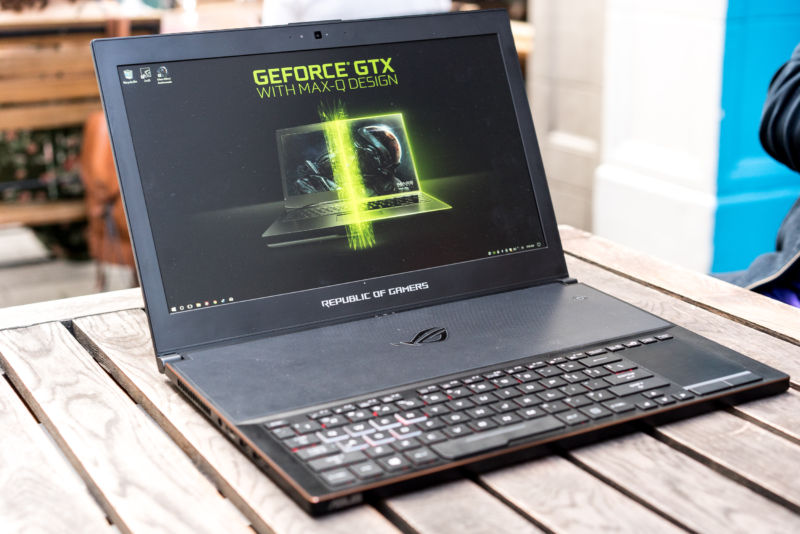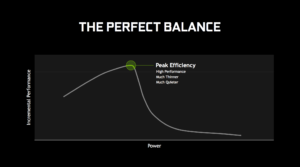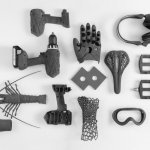
Nvidia’s Max-Q initiative, which aims to slim down bulky gaming laptops with hand-picked chips and recommended dimensions and acoustics, has produced three laptops so far: The Clevo P950, Asus Zephyrus, and MSI GS63. While the MSI GS63 uses the same slim chassis as its predecessor—which was part of Nvidia’s 10-series laptop launch—both Clevo and Asus have created something new for Max-Q. In the case of Asus at least, the new design is particularly wacky.
But let’s start with the basics. Max-Q is Nvidia’s attempt to make the gaming laptop more portable by giving OEMs like Asus and Clevo access to GTX 1080, GTX 1070, and GTX 1060 GPUs that hit a sweet spot between performance and power. These specially selected chips perform nearly as well as the standard laptop parts, but require far less power when under load. The GTX 1080 goes from a rated max power consumption of 150W to between 90W and 100W, the GTX 1070 goes from 115W TDP to 80W-90W, and the GTX 1060 goes from 80W to 60-70W.
Less wattage means less heat, which in turn means less cooling, resulting in thinner and quieter laptop designs. While Nvidia hasn’t put a hard restriction on the physical dimensions of Max-Q laptops—the Clevo comes in at 19mm thick, the Asus at 18mm—it is pushing for a limit on fan noise. Max-Q laptops have an upper limit of 40dbA when under load. If a laptop goes over that it doesn’t make the cut, and misses out on access to Max-Q chips and branding.

In an effort to make the laptops even quieter, Nvidia’s GeForce Experience software now includes a “WhisperMode” setting. WhisperMode balances visual settings with frame rate to hit a sweet spot in power consumption. Over 400 games have been profiled so far, with more due to be added over the coming months. It’s worth noting that WhisperMode is in addition to Nvidia’s 40dbA noise limit, so in theory Max-Q laptops should run even quieter when it’s enabled.
Even with low wattage chips, manufacturers still have a challenge to hit the 40dbA limit while creating a portable design. Asus’ solution for the Zephyrus is particularly novel, if a little impractical. Asus has shifted the keyboard down to the bottom of the laptop, leaving a large space above it for speakers and air intake. When the Zephyrus is opened, a mechanical hinge pushes up a flap that runs across the entire back edge of the laptop. This not only angles the laptop up (handy!), but also creates a huge space for venting hot air.
Unfortunately, pushing the keyboard down to the bottom edge of the Zephyrus is an ergonomic nightmare. It’s not so bad if you’re sat at desk where you can rest your wrists on the desk (although, it’s hardly the most comfortable typing experience). But on the go—and given the whole point of Max-Q is to create gaming laptops that can feasibly double up as a normal laptop, this is a valid use case—the Zephyrus is all but unusable.
Forget about typing in cramped economy airplane seats, on train tray tables, or with the Zephyrus perched on your lap. Instead, be prepared to flail at the keyboard like a tiny-armed T-Rex as you look on with envy at those who purchased laptops for grown-ups. The placement of the keyboard is such a shame, because otherwise the Zephyrus would be a great laptop. It’s thin at 18mm, has plenty of ports—including USB Type-C, four USB 3.1 ports, HDMI, and a headphone jack—and the power to run pretty much anything you can throw at it thanks to a four-core, eight-thread Intel Core i7 7700HQ CPU, up to 24GB of DDR4 RAM, four M.2 PCI ports, and a GTX 1080.
The only thing that could do with a bump, aside from the awful keyboard, is the screen. It comes with a 15-inch 1080p 120Hz G-Sync screen as standard. While it’s a lovely panel, 1080p, even at 120Hz, is hardly taxing for a GTX 1080. Ideally the Zephyrus would come with a 1440p 120Hz panel, although I’m told those are very hard to come by. Those after a high resolution can opt for a 4K screen, but that tops out at 60Hz.
The Clevo P950 is a more traditional laptop, but the one I prefer after a brief hands-on. Clevo doesn’t have a great track record with thin-and-light laptops, instead creating 17-inch monstrosities that often get rebranded and sold on by the likes of Scan. But the P950 is a vast improvement. It has a sturdy metal chassis that comes in at 19mm thick, along with relatively subdued styling. There are loads of ports—two USB Type-C, three USB 3.1, Ethernet, two mini-DisplayPort, a headphone jack, and an SD Card reader—along with varying specs that include an Intel i7 CPU, a GTX 1070 graphics card, and a 15-inch 1080p display.
Most importantly, it has a keyboard in the correct place to actually type things, which is a good starting point for a laptop. The P950’s cooling system is more traditional, but it should still come in at 40dbA under load.
Battery life for both laptops remains a mystery, as does price. While the specially selected chips are likely to result in at least some sort of price premium, Nvidia says laptops shouldn’t cost much more than a typical GTX 1080, 1070, or 1060 laptop. Right now, a GTX 1080 laptop goes for around £2,000. That sort of money buys a high-end Dell XPS laptop, a Razer Blade, or a MacBook Pro, all of which sport significantly better, more practical designs than what both Asus and Clevo are offering, albeit not as powerful.
Nvidia Max-Q is a step in the right direction for gaming laptops, but acoustic recommendations and more efficient chips can only go so far. OEMs need better industrial designs if they want gaming laptops to take the place of a regular laptops.
With that said, both Razer and Dell have signed up to create Max-Q laptops; they just haven’t arrived yet. A Dell XPS 13 with a GTX 1060 inside? Now that’s a laptop I’m looking forward to.
[“Source-ndtv”]










